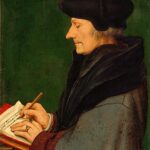Even Switzerland, with its many (dissolved or still-functioning) monasteries and monumental (Reformed and Catholic) churches, will not formally be a Christian country in the foreseeable future. In the foreseeable future, most of its citizens will be ‘without religion’.
However, in terms of symbolism, a country cannot be more Christian than Switzerland. The Swiss cross in the national flag, the red cross of the International Red Cross, the arms of various cantons (among others, the bishop’s staff of the cantons of Basel-Landschaft, Basel-Stadt and Jura, the keys of St Peter of Obwalden and Nidwalden or Saint Fridolin of Glarus), the national anthem is a psalm and the Constitution begins with the words ‘In the name of the Almighty God’.

Interior of the St. Peter Church in Gelterkinden
Although the Christian religion is rapidly declining in importance, the social, humanitarian and humanistic function of churches at the local level will hopefully not be lost. At least the cultural heritage of Christianity is respected and maintained in Switzerland.
Not only does the country have the oldest dioceses north of the Alps (Chur, Kaiseraugst/Augst (Augusta Raurica)–Basel, Martigny-Sitten, Avenches-Lausanne and Geneva), it also maintains the Frankish, Carolingian, Romanesque, Gothic, Baroque, Rococo and Neoclassical heritage, not to mention some startling 20th-century churches.

The St. Gallus Church in Kaiseraugst
As is well known, Christianity developed within the administrative, logistical, cultural, and political structures of the Roman Empire. The bishopric in Augusta Raurica is one example. The bishop’s palace and church were among the first in Switzerland until the 6th century when he moved to the Münster in Basel.




Kaiseraugst lies on the Rhine, and one of its smaller water suppliers is the stream Ergolz, which flows into the Rhine at Augst. Upstream to its source on the Geissflue in the Jura are various monumental (Catholic and Reformed) churches.
The region was inhabited in Roman times by the Celtic tribe of the Rauraken. The emigration of the German-speaking pagan Alemanni after the departure of the Romans in the fifth century did not mark the end of the Christian world of the Romanised Celts (Gallo-Romans). The Christian Franks defeated the Alemanni. They continued Christianity in this region, and the building of churches began.

Oltingen, St. Nikolaus Church
The towns and villages of Liestal, Sissach, Ormalingen, Otlingen and nearby Arisdorf and Gelterkinden host some sites of Switzerland’s remarkable Christian heritage upstream of the 30-kilometre Ergolz.
Impressions
Oltingen, Kirche St. Nikolaus



The old ‘Beinhaus’ on the left




Ormalingen, Kirche St. Nikolaus


Sissach, Kirche St. Jakob






Liestal, Kirche St. Martin

Arisdorf




Gelterkinden








(Source and further information: Gesellschaft für Schweizerische Kunstgeschichte/ Société d’histoire de l’art en Suisse)

















































